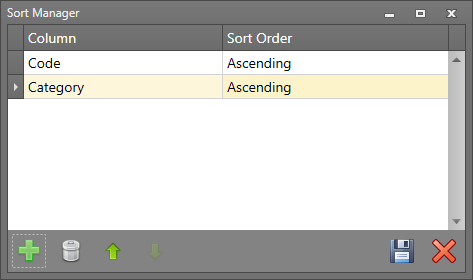Sort Order
If a configured or user-defined sort-order has not been set, by default, the records in a table will be sorted by primary key when the table is opened. To set a user-defined sort-order for the current logging session, a Sort Order option is available on the Main Toolbar Ribbon when you enter or edit data:

A table sort order may be applied based on multiple columns:

When you edit an existing profile, or setup a new profile, you can also set the sort order for a table by clicking a Sort button on the toolbar of the COLUMNS tab of the Edit Logging Profile screen. In this context it is called Sort Priority. This configured sort order is prioritized over the default order when a user starts logging. As noted above the user can rearrange the sorting if desired during their logging session.
In the Sort Manager, add one or more columns to define an Ascending or Descending sort order for each column. You can use the arrows on the toolbar to change the order and priority of the columns in the list.
- If you are editing or entering data, the column order you have defined will be used to sort the data.
- If you are editing a logging profile, the column order you have defined will be set for the table you are editing.
- Note: In File | Options | Usability, you can also set an option to always show blank records after other records, within the context of the sort order.
| Option | Description |
|---|---|

|
Add one or more columns to define a sort order for the current table. |

|
Delete the selected columns. |

|
Move selected columns Up. |

|
Move selected columns Down. |

|
Click the Save button to save and apply the sort order you have defined and close the dialog. |

|
Click the Close button to close the Sort Order/Sort Priority dialog. |
Note: When designing a profile if it is likely there will be groups of records for which primary key values may be blank, then include other columns in the configured sort to ensure records are displayed in meaningful order.
Before carrying out updates or inserts using the Increment, Replicate or Execution parameter functions, to avoid resorting, ensure the sort order is consistent with the values which will be incremented. For example, set an ascending sort if values will be incremented.